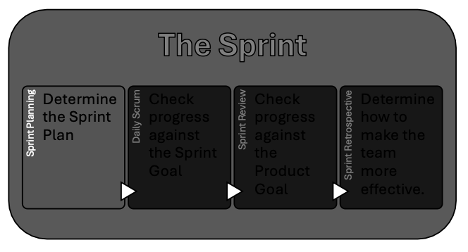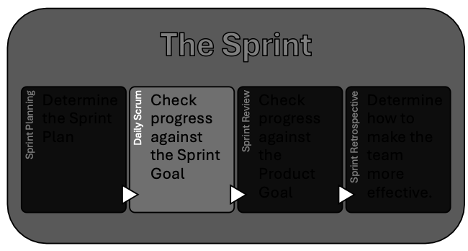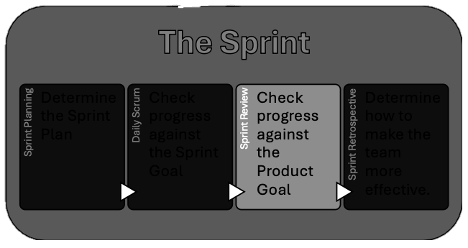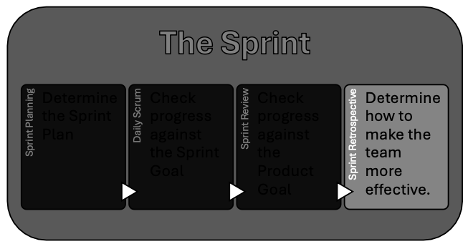Table of Contents
- Introduction
- Understanding the Sprint
- Sprint Planning
- Daily Scrum
- Sprint Review
- Sprint Retrospective
- Conclusion
Introduction
Welcome to Scrum Events and Activities, where you will gain a comprehensive understanding of the key events within the Scrum framework. These events are essential for maintaining the rhythm of a Scrum team, ensuring transparency, accountability, and continuous improvement. In this module, we’ll explore the Sprint, Sprint Planning, Daily Scrum, Sprint Review, and Sprint Retrospective in detail.
Understanding the Sprint
At the heart of Scrum is the Sprint, a time-boxed iteration that typically lasts between 1 to 4 weeks. The goal of each Sprint is to create a usable product increment—a piece of potentially shippable software or product functionality. Sprints enable teams to work in a consistent, predictable manner, promoting continuous delivery and regular feedback.
Characteristics of a Sprint:
- Time-Boxed Iteration: A Sprint is a fixed-length period where a set of work is completed and reviewed.
- Consistency in Duration: All Sprints should be of the same length to establish a predictable rhythm.
- Commitment to the Sprint Goal: The team commits to a goal for each Sprint, guiding their focus and prioritization.
Why Sprints Matter:
- Enables Continuous Delivery: Teams deliver work incrementally, allowing frequent inspection and adaptation.
- Facilitates Regular Feedback: Sprints create opportunities for feedback from stakeholders and end-users.
- Encourages Incremental Progress: Small, manageable chunks of work help the team avoid the pitfalls of big-bang releases.
Sprint Planning
The Sprint Planning meeting marks the start of every Sprint. This is where the Scrum team aligns on the Sprint Goal, selects the Product Backlog items to be worked on, and breaks them down into actionable tasks.

Sprint Planning Logistics:
- Timing: First part of the first day of the Sprint.
- Participants: Scrum Team; stakeholders may attend to provide clarity or answer questions.
- Duration: No more than 8 hours, but it may be shorter depending on the Sprint length.
Steps in Sprint Planning:
- Determine the Sprint Goal: Align the team on a clear, achievable objective for the Sprint.
- Select and Prioritize Backlog Items: Choose the most important Product Backlog items that fit the Sprint Goal.
- Break Down Tasks: Decompose the selected items into tasks and estimate the effort required.
Daily Scrum

The Daily Scrum is a 15-minute time-boxed event that occurs every day of the Sprint. It is a key opportunity for the team to synchronize their work and ensure they are on track to meet the Sprint Goal.
Daily Scrum Logistics:
- Timing: Happens daily during the Sprint.
- Participants: Only the developers are required to attend, but anyone can join.
- Duration: Strictly limited to 15 minutes.
Conducting Effective Daily Scrums:
- Transparency Tools: Use task boards or other tools to visualize progress.
- Three Key Questions (optional): Each team member answers:
- What did you do yesterday to help achieve the Sprint Goal?
- What will you do today to help achieve the Sprint Goal?
- Are there any impediments in your way?
- Validating the Current Situation: Assess progress and adjust the plan if necessary.
Sprint Review

The Sprint Review is held at the end of the Sprint, just before the Sprint Retrospective. Its purpose is to inspect the Increment and adapt the Product Backlog based on feedback from stakeholders and what is needed to achieve the Product Goal.
Sprint Review Logistics:
- Timing: Second to last event of the Sprint, usually on the last day.
- Participants: Scrum Team and stakeholders.
- Duration: No more than 4 hours, but shorter for shorter Sprints.
Steps for Conducting a Sprint Review:
- Inspect the Product Increment: Demonstrate the work completed during the Sprint.
- Discuss Next Steps: Engage in discussions about what should be done next.
- Focused Demos: Keep demonstrations short and focused on completed work.
Sprint Retrospective

The Sprint Retrospective is the final event of the Sprint, where the Scrum team reflects on their processes and identifies ways to improve in the next Sprint.
Sprint Retrospective Logistics:
- Timing: Last event of the Sprint.
- Participants: Entire Scrum Team.
- Duration: Up to 3 hours.
Conducting Effective Sprint Retrospectives:
- Reflect on Practices: Discuss what went well, what didn’t, and how to improve.
- Identify Improvements: Prioritize a few key improvements to implement in the next Sprint.
- Actionable Outcomes: Create a plan for improving processes, tools, or communication.
Conclusion
By the end of this module, you will have a solid understanding of how to facilitate each of the core Scrum events. You’ll also understand the importance of maintaining consistency, transparency, and collaboration within your team. These events are the pillars that ensure continuous improvement and incremental progress within Scrum.
Key Takeaways:
- Sprints provide structure and rhythm to the team’s work.
- Sprint Planning aligns the team around a common goal and work plan.
- The Daily Scrum keeps the team synchronized and focused on the Sprint Goal.
- The Sprint Review allows for feedback and adaptation of the product.
- The Sprint Retrospective fosters continuous improvement within the team.
